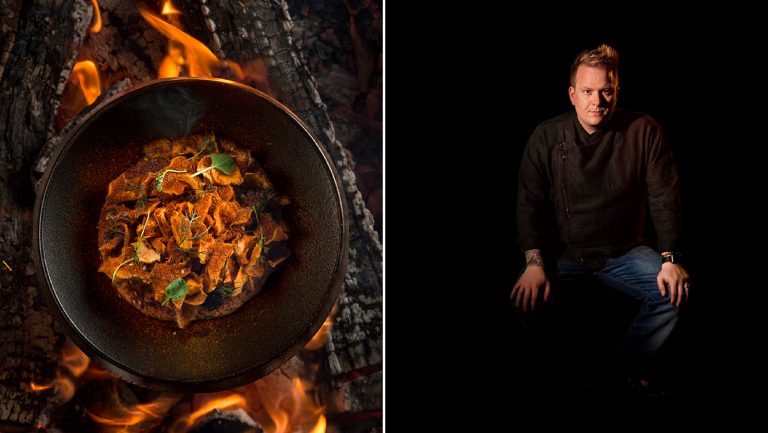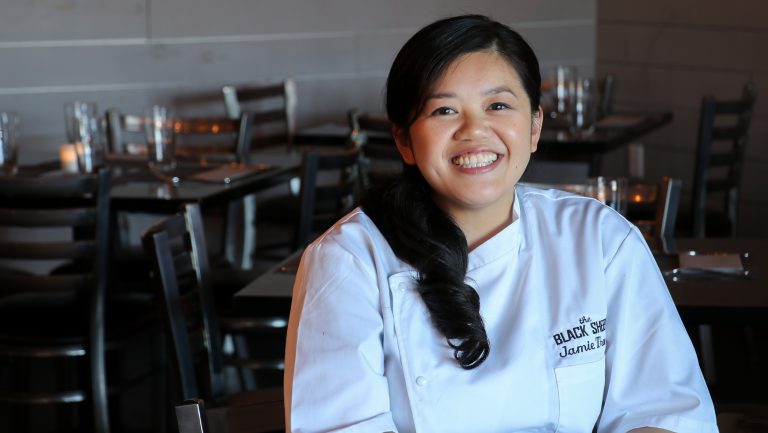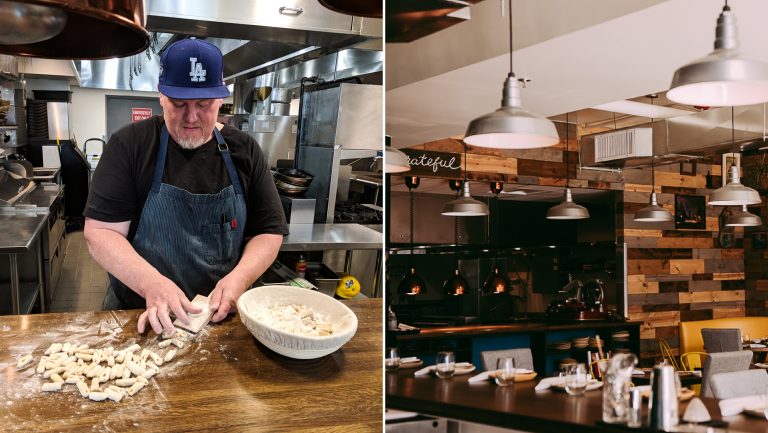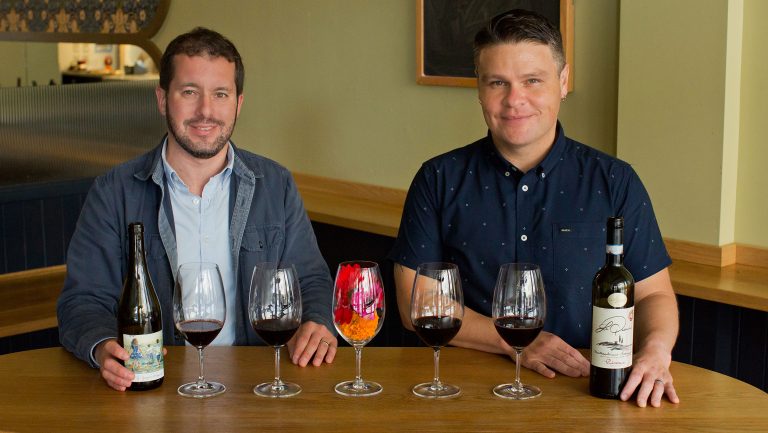Between racking up reservations at celebrity chef–branded restaurants, taking in Cirque du Soleil performances, and sipping overpriced bubbly in extravagant lounges, there is little time to hit the slot machines let alone venture off the Strip on most entertainment-fueled Las Vegas itineraries. Locals, however—and an increasing number of in-the-know travelers eager to shun the 24-hour glitz for a welcoming dose of low-key conviviality—revel in the city’s culinary delights away from the mega casinos.
Like the Vegas bars Herbs & Rye, Velveteen Rabbit, and Starboard Tack, all coveted, comfortable off-Strip destinations, restaurants in far-flung areas of the city are now quietly making waves. “Most visitors never leave the Strip,” says Vegas hospitality consultant Eric Gladstone. “They say they’ll check out the other parts next time, but they should be doing it now.”
Taking a Risk
Among the Vegas veterans encouraging off-Strip explorations is Sheridan Su, the 2018 James Beard Award semifinalist behind the Hainanese Chicken Rice joint Flock & Fowl and the Asian comfort food diner Fat Choy. Su is one of a number of chefs who, though he has an impressive Strip pedigree, including Joël Robuchon at the Mansion at the MGM Grand and the Cosmopolitan’s Comme Ça, says he craved being able to cook in a more down-to-earth, engaging atmosphere.

Don’t miss the latest drinks industry news and insights. Sign up for our award-winning newsletters and get insider intel, resources, and trends delivered to your inbox every week.
Brian Howard, the chef-owner of Sparrow + Wolf in Vegas’s flourishing Chinatown is a Detroit native, who moved to Vegas some 20 years ago on a whim. He hadn’t visited before, but after watching the movie Casino he instinctively felt “it was one of those cities that if you take care of it, it will take care of you—or it will chew you out.”
From Lutèce and Thomas Keller’s Bouchon at the Venetian to Kerry Simon’s CatHouse at Luxor to Comme Ça, Howard had a successful run on the Strip. “I love Vegas. No one does hospitality better than us,” he says. “I did a good job of making a name for myself, working my way up the management roles, and running other people’s restaurants, but I always wanted to create my own.” That dream came true last year when Howard opened Sparrow + Wolf, where, he says, “I could cook the way I wanted without anyone holding me back.” Now, he’s turning out dishes like beet and green apple tartar; beef cheek and bone marrow dumplings with spring onion and lemon ash; and wood-fired lasagna with lamb Bolognese, miso, and burrata.

James Trees hails from Las Vegas. Earlier this year the chef unveiled Esther’s Kitchen, a seasonal Italian restaurant, serving pizzas made with natural sourdough crust and pasta dishes like cavatelli strewn with crispy sausage, smoked tomato, and rabe. “I opened in a part of town where every other restaurateur didn’t want to risk coming to. Why would I want to be anywhere else?” Trees says of the antique shops–laden Arts District he gravitated to. Patrons feel similarly; they come early to savor a pre-dinner Jess’ Girl (mezcal, kumquat, pink peppercorn) and happy hours starring $5 red, white, and sparkling wines.
By the age of 16, Trees was already an intern at the Mirage, planted at a butcher station where, he says, “I thought it was great to cut meat by the air conditioner.” A number of remarkable placements eventually followed, leading Trees to work with such luminaries as Bradley Ogden, Alex Stratta, and Michael Mina on the Strip, where the restaurants, he points out bluntly, tend to have “gorgeous spaces and unlimited budgets, but are fantasies.” On returning to his hometown in 2017 from Los Angeles, where he’d been working for a decade, Trees knew it was time to embark on a more soulful venture set apart from the Strip.
A similar stirring led Jamie Tran, who is originally from Northern California, to open the Black Sheep with her partners Andy Hooper and Jon Schwalb in Southwest Las Vegas last year. The Black Sheep is where Tran experiments with dishes like Vietnamese crepes with braised Duroc pork belly and Thai basil shrimp ceviche spiked with fermented yuzu avocado mousse. The bar turns out vibrant cocktails to match, like La Flama Blanca (Kai Lemongrass Ginger Shochu, Thai chile-infused simple syrup, egg white, chile flower), an ode to Kenny Powers in the HBO sports comedy Eastbound & Down.
This approach is a departure from Tran’s classical background. Her career was launched at Aureole by Charlie Palmer in Mandalay Bay, where she worked her way up from line cook to sous chef before “cooking for hundreds of thousands of convention-goers and meeting guests in the banquet department of the Venetian.” When she was recruited as the executive chef for Daniel Boulud’s db Brasserie, also in the Venetian, she serendipitously met Hooper, who was then its director of operations.
“Casino restaurants are mass driven, so you have to crank out a lot in a short amount of time to meet the demand,” says Tran. “It can be hard to focus clearly on the food when you have to get 300 covers out in a night.” After db Brasserie closed in January 2017, Tran realized it was time for a new adventure. “I wasn’t growing anymore in the corporate setting,” she says, “and I wanted to do things I had in my head that I was holding back on.” These days, Tran generally avoids the Strip, and knowing that a lot of locals feel similarly, the Black Sheep aimed to offer from the get-go “a menu of Strip-quality food for people to enjoy without the hassle. It was a risk,” Tran says, “but I jumped right in.”
Going Your Own Way
Tran credits working on the Strip for strengthening her skills and teaching her how to overcome any challenge. “While so many procedures and bureaucratic decisions can sometimes be stifling,” she says, “it also helped me to become disciplined.” Commodious kitchens, simplified vendor relationships, and a large pool of staff candidates are all perks of the Strip life, Tran admits. Yet “having to fulfill someone else’s vision and not being able to express myself creatively” was certainly the downside. She adds, “This is the first time I’ve seen my team, who I’ve worked with at other Strip properties, pulling out their recipes and making new dishes. It makes me happy that they’re finding their creativity again, too.”

On the Strip, “obviously you work hard, but the success or failure of the restaurant doesn’t fall squarely on your shoulders at the end of the day,” Tran says. Now, without the shield of a big chef’s name to hide behind, Tran puts the pressure on herself to deliver. She knows it’s her reputation that is solely at stake.
Although Howard appreciated the big budgets and choice time slots for food deliveries that were par for the course on the Strip, he says he wasn’t satisfied with the creative limitations and emphasis on the bottom line that also dominated. “I might have gotten a better price on the Strip,” he says, “but at Sparrow + Wolf, I can focus on products that are much closer to home and on the people behind them.”
Trees also loves that he can now source any obscure product he desires without needing to ask permission of anyone. “I can just call up and say, ‘Here’s what I want,’” he says. “There’s no bullshit, no ‘Send us the cost and we’ll see if it works.’” Still, food costs at Esther’s Kitchen remain low, he says, because the concept is “built around flour and water, not flying in ingredients from Japan.”
These days, Trees is the one who personally calls plumbers and electricians when problems arise, paying cash for their services out of his own pocket, but as he puts it, either the entrepreneurial spirit runs through you or it doesn’t. “One of the things you can’t be when you’re running your own place is average,” he says. “Your job might be secure on the Strip, but you also have to make that same steak a million times and suck it up when your boss flies in on his private jet and takes credit for your stuff.” Trees, for one, would rather navigate unpredictable turf than continue slipping into a uniform on the Strip and creating the same dishes day after day.
Building a Community
About 80 percent of Trees’s diners are locals, and he’s happy they are such fans. “I want to cook for my neighbors,” he says. But he also hopes to see more tourists seduced by his menu, where nothing is over $28. Overcharging doesn’t have to be synonymous with the city. Says Trees, “I want to bring some honesty back to Vegas restaurants.”

Howard says that he’s been noticing a rise in out-of-towners lately, and he thinks that’s a reflection of positive word of mouth. “It’s such a tight-knit community and people are rooting for us,” he says. “There’s enough for everybody to go around, so we don’t have to be cutthroat. Everybody wants everybody to succeed.” Sparrow + Wolf, he adds, was meant to prioritize old-school hospitality, “getting to know every guest and what they want to eat and drink. It’s easy to lose sight of that on the Strip.”
Unlike the transient Strip guests, locals are supportive. Tran says repeat customers at the Black Sheep “are excited and appreciate the changes on the menu and within the restaurant. They tell you the truth about what they think, good or bad.” To her, it’s a relationship, not a mere transaction. All this positivity has created another priceless element for Tran—the sense of pride she sees her employees bask in simply because they work at the Black Sheep.
“I didn’t get that sense on the Strip,” she says. “It was a corporate job where you got a paycheck and went home.”

Dispatch
Sign up for our award-winning newsletter
Don’t miss the latest drinks industry news and insights—delivered to your inbox every week.
Alia Akkam is a writer who covers food, drink, travel, and design. She is the author of Behind the Bar: 50 Cocktails from the World’s Most Iconic Hotels (Hardie Grant) and her work has appeared in Architecturaldigest.com, Dwell.com, Penta, Vogue.com, BBC, Playboy, and Taste, among others, and she is a former editor at Edible Queens, Hospitality Design, and Beverage Media. A native New Yorker, Alia now calls Budapest home. Follow Alia @behdria.







